Ornamental Grasses and Grass-Like Plants for Oklahoma
- Jump To:
- Culture and Maintenance
- Soil
- Pests
- Grasses and Grass-like plants for Different Landscape Needs
- Plants for Water Gardens, Rain Gardens, Standing Water, and Bogs
- Plants for Shady Locations
- Plants for Dry Shade
- Plants for Containers
- Plants for Screens
- Plants for Erosion Control
- Plants that Self-seed
- Plants for Hot and Dry Locations
- Plants for Prairie Restoration
- Alternative Plants for Lawn Grasses in Sunny Locations
- Alternative Plants for Lawn Grasses in Shady Locations
- Plants with Fall Color* and Winter Interest
- Table 1. Perennial Grasses:
- Table 2. Annual or Tender Perennial Grasses:
- Table 3. Grass-Like Species:
- Table 4. Miscanthus Species/Cultivar List
- Table 5. Carex Species and Cultivars
- Table 6. Bamboo Species:
- Resources:
- Sources:
The term ornamental grass is used to include not only true grasses (Poaceae) but close relatives such as sedges (Cyperaceae), rushes (Juncaceae), hardy bamboos (particularly the genus Phyllostachys) and others. This fact sheet presents ornamental grasses and grass-like plants adapted to Oklahoma. Listings are for USDA hardiness zones 6-8. Some popular tender grasses, grown as annuals, also are listed.
- Grasses are adaptable and can grow in poorer soils better than many other garden plants.
- Grasses require little effort to maintain once established.
- Grasses come in many heights, colors, textures and have varying water requirements.
- Grass seed heads and foliage add fall and winter interest.
- Dried grasses have many decorative uses indoors and out.
- Grasses can be used as groundcovers, specimen plants, for erosion control and as vertical design elements.
| Figure 1. Ornamental grasses grown in a landscape bed at the Botanic Garden at OSU. |
|---|
 |
Ornamental grasses and grass-like plants can add a great deal of value to the landscape. Many are easy to grow and have very few pest problems. They have unique form and texture compared to many other landscape plants and provide year-round interest. In addition to the form, texture and colors that many species offer, they also provide movement as they sway back and forth in the gentlest of breezes.
Our Oklahoma native species are considered essential members of the short and tall grass prairies and the crosstimber areas that make up much of Oklahoma. Native species therefore work well in wildflower and prairie gardens and some woodland settings. Native species attract wildlife to the garden. Birds use leaf blades for nesting and seed of some grass species provide food.
Oklahoma’s unique climate and ecoregions provide many opportunities and choices when it comes to grasses and their grass-like relatives. When selecting ornamental grasses consider their function in the landscape. Depending on the species they may be used for an accent, erosion control, as a groundcover, to attract wildlife, as a screen and even as lawn substitutes. Native sedges are finding increased use as lawn alternatives that need much less water, spraying, feeding and mowing. Many of our shortgrass prairie species can be used for lawns too like buffalograss and grama grasses. Many species work well in containers or as part of a container arrangement. There is a tremendous range in sizes from small, petite grasses that only grow a few inches high to large grasses that can reach up to 14 feet. Most grasses are perennial, though there are several annuals as well as tender perennials used as annuals in Oklahoma. Grasses come in a wide variety of color other than green. There are yellow or golden varieties, red to pink, blue to purple and variegated forms. Grasses that go dormant in winter turn natural colors such as brown, tan, and gray, which provide color and interest during the winter months.
Culture and Maintenance
Ornamental grasses can be planted just about any time of year (particularly containerized specimens); however, for establishment purposes cool-season grasses are best planted in the late summer and fall and warm-season grasses in late spring and early summer. Supplemental watering may be necessary the first season after planting.
Beds should be free of unwanted and aggressive weeds like bermudagrass. While there are organic methods to controlling bermudagrass among ornamental grasses, most require diligent, extensive labor. The use of herbicides is generally needed and may need several applications to get complete control. Getting control of existing weeds prior to planting is much easier than controlling them after ornamentals are planted.
Most grasses prefer full sun; a handful of species prefer or tolerate part sun while others need to be in semi-shady areas due the late afternoon sun and heat. Species or cultivars with red or purple foliage will have more vivid color if grown in full sun and may turn green in shade.
Water according to species’ needs. Some require very little water once established. Consider watering in winter during long dry periods (more than four weeks without 1 inch of precipitation); water prior to freezing temperatures.
Spacing of grasses is determined on the desired effect of the planting. A general rule for spacing is equal to the mature height of the plant (plants 2 feet tall are spaced 2 feet apart). If the plants are being used as specimens, they can be planted further apart. Species used for groundcovers, screens, or hedges or that spread horizontally can be spaced based on mature widths. Some plants create thick clumps of grass blades coming from the base of the plant and will often stay in that one place but gradually increase in diameter. Other grasses, however, spread through rhizomes and/or stolons, spreading horizontally more quickly.
Grasses are easily propagated through division (digging the plant and cutting it into smaller sections, each with stem and roots). Hybrids or named cultivars can only be propagated by division as they will not come true from seed. Some cultivars produce sterile seed and must also be propagated by division. Seed propagation is often used with native grasses for prairie restoration or for planting large areas. Note that patented selections are illegal to propagate without a licensing and/or royalty agreement.
Division may be needed if the plant has poor vigor and/or is declining, or if more plants are needed. Most grasses benefit from spring division. Large mature grasses may need division when the center of the plant is dead, this is particularly common on clump forming grasses. Digging and cutting large specimens usually require considerable manual labor. When appropriate, mechanical equipment such as a backhoe and a saws-all will save a lot of time and effort. Ornamental grasses are very tough and can handle a lot of abuse during the division process. However, it is important when physically cutting a plant apart to ensure each new division has some roots and crown of the original plant. Depending on the size of the plant and the desired size of the divisions, the original can often be divided into halves or quarters.
Most ornamental grasses need to be cut back each year. The best time to cut them back is late winter or early spring just before new growth begins. If not cut back, the plant may look unattractive with dead material among the new leaves. Manually cutting grasses back can be done easily with a pair of hedge sheers for small areas (electric hedge trimmers make the job even easier). Many species have serrated leaf margins, so gloves may be necessary to protect your hands. If permitted, large areas may be burned. This may require permits and should be done under close supervision. While cutting grasses back can make a lot of garden debris to remove from the landscape, the material can also be utilized in the landscape or vegetable garden, as straw mulch, in paths, or simply add it to the compost pile.
Soil
Most ornamental grasses will grow in a wide range of soils with a pH range of 5.0 to 8.0. Well-established grasses rarely need fertilization or irrigation except in extreme cases such as drought or very sandy soils. Overfertilization of grasses, especially with fertilizers high in nitrogen, and overwatering, can lead to weak stems resulting in lodging (grasses flopping over). Native grasses prefer unamended soils; rich soils tend to make plants weak and flop over.
Pests
Ornamental grasses have few pest problems. Weeds are generally the biggest problem and are controlled through hand weeding or spot treatments of a contact herbicide for persistent weeds. Care should be taken when applying herbicides to avoid damaging the ornamental grasses as well as other desirable plants in the area. Be sure to choose a product that is listed to control the types of weeds you are dealing with and in the site that they are growing.
Grasses and Grass-like plants for Different Landscape Needs
Grasses and grass-like plants recommended in the next sections are merely examples of what grows well in Oklahoma. Lists provided are not comprehensive but are to assist the homeowner in working with their local horticulturists and professionals. Some plants mentioned may not be suited for all landscape situations but are intended to fill specific needs in the landscape. Sometimes a compromise in plant selection may be necessary for the specific purpose to be realized.
Plants for Water Gardens, Rain Gardens, Standing Water, and Bogs
Acorus spp., sweet flag
Carex spp., sedge
Chasmanthium latifolium, northern sea oats
Elymus hystrix, eastern bottlebrush
Juncus effusus, common rush
Leymus arenarius, blue lymegrass
Miscanthus ‘Purpurascens’, red flame miscanthus
Miscanthus sacchariflorus, silver banner grass
Panicum virgatum, switch grass
Phalaris arundinacea, reed canary grass
Spartina pectinata, cordgrass
Spartina pectinata ‘Aureomarginata’, variegated cordgrass
| Figure 2.1 and 2.2 Golden Variegated Sweet Flag, Acorus gramineus 'Ogon'. |
|---|
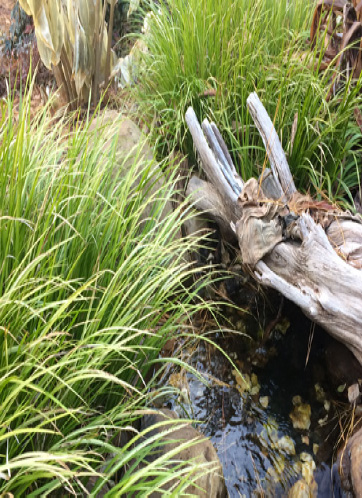 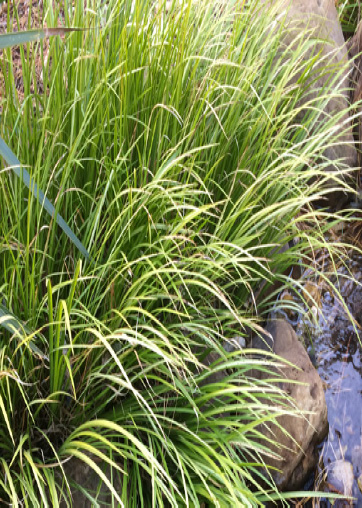 |
| Figure 3. Big Twister Rush, Juncus effusus ‘Big Twister’. |
|---|
 |
Plants for Shady Locations
Acorus gramineus, Japanese or grassy-leaved sweet flag
Andropogon gerardii, big bluestem
Andropogon glomeratus, bushy bluestem
Andropogon ternarius, split beard bluestem
Calamagrostis arundinacea var. brachytricha, fall-blooming reed grass
Carex spp., most sedges
Chasmanthium latifolium, northern sea oats
Cyperus spp., papyrus or paper plant
Elymus hystrix, eastern bottlebrush
Equisetum hyemale, scouringrush or horsetailrush
Erianthus contortus, bent awn plume grass
Festuca glauca, blue fescue (light shade)
Hakonechloa macra cultivars,
Imperata brevifolia, satintail
Juncus spp., rushes
Luzula spp., woodrush
Molinia caerulea subsp. caerulea ‘Variegata’, variegated moor grass
Panicum virgatum, switch grass
Pennisetum spp., fountain grass (light shade)
Phalaris arundinacea ‘Picta’, ribbon grass
Phalaris arundinacea var. luteo-picta, yellow ribbon grass
Phalaris arundinacea ‘Feesey’s Form’, Feesey’s ribbon grass
Setaria palmifolia, palm grass
Spartina pectinata ‘Aureomarginata’, golden-edged prairie
cord grass
Spodiopogon sibiricus, frost grass
Stenotaphrum secundatum ‘Variegatum’, Variegated St. Augustinegrass (light shade)
Sisyrinchium angustifolium, narrow-leaf blue-eyed-grass
Tripsacum dactyloides, eastern gamagrass
Zoysia spp., zoysiagrass (light shade)
| Figure 4.1 and 4.2. Northern Sea Oats, Chasmanthium latifolium (left). Variegated Japanese Forest grass, Hakonechloa macra ‘Aureola’ (right). |
|---|
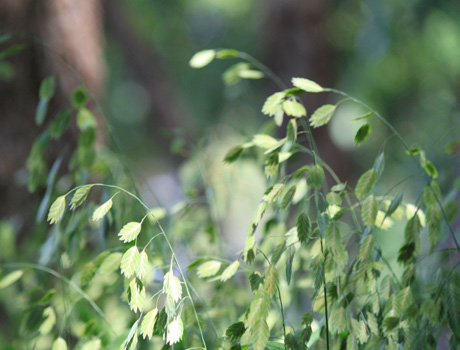  |
Plants for Dry Shade
Carex leavenworthii, leavenworth's sedge
Carex pensylvanica, Pennsylvania sedge
Erianthus contortus, bent-awn plumegrass
Festuca glauca ‘Elijah Blue’, Elijah Blue fescue (light shade)
Festuca spp., fescue, (light shade)
Helictotrichon sempervirens, blue oat grass (light shade)
Liriope spp., lilyturf
Ophiopogon spp., mondograss
Panicum virgatum, switch grass
Pennisetum spp., fountain grass (light shade
Phalaris arundinacea, ‘Picta’, ribbon grass
Phalaris arundinacea var. luteo-picta, yellow ribbon grass
Phalaris arundinacea ‘Feesey’s Form’, Feesey’s ribbon grass
Phormium tenax, New Zealand flax
Tridens flavus, purpletop
| Figure 5.1, 5.2 and 5.3. Elijah Blue Blue Fescue, Festuca ovina ‘Elijah Blue’ (top). Dwarf Mondograss, Ophiopogon japonicus ‘Nana’ (middle). Monkeygrass, Liriope species (bottom). |
|---|
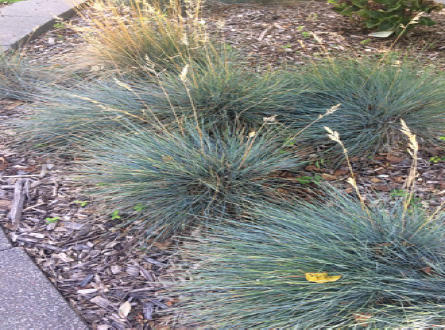 |
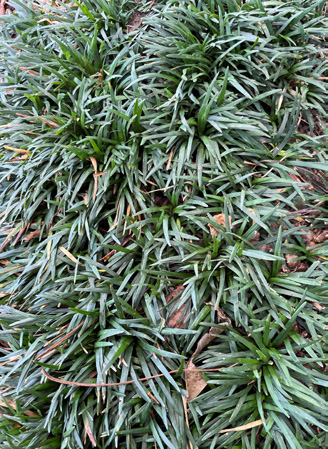 |
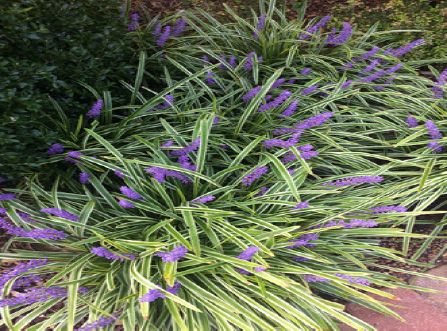 |
Plants for Containers
Acorus calamus ‘Variegatus’, variegated sweet flag
Acorus gramineus ‘Ogon’, golden variegated sweet flag
Calamagrostis x acutiflora ‘Overdam’, Overdam feather reed grass
Calamagrostis x acutiflora ‘Avalanche’, Avalanche feather reed grass
Carex spp. and cultivars, sedges
Chasmanthium latifolium, northern sea oats
Festuca glauca ‘Elijah Blue’, Elijah Blue fescue
Hakonechloa spp. and cultivars, Japanese forest grass
Helictotrichon sempervirens, blue oat grass
Imperata ‘Red Baron’, bloodgrass
Melinus nerviglumis ‘Pink Crystals’, ruby grass
Miscanthus sinensis ‘Variegata’, variegated miscanthus
Miscanthus sinensis var. condensatus ‘Caberet’, Caberet miscanthus
Pennisetum alopecuroides ‘Little Bunny’, dwarf fountain grass
Pennisetum glaucum ‘Purple Majesty’, Purple Majesty millet
Pennisteum setaceum, crimson fountain grass
Pennisteum setaceum ‘Rubrum’, purple fountain grass
| Figure 6. Pink Crystals Ruby grass, Melinus nerviglumus ‘Pink Crystals’. |
|---|
 |
Plants for Screens
Screens over 5' tall:
Andropogon gerardii, big bluestem
Cortaderia selloana, pampas grass (not as cold hardy in northern OK)
Miscanthus spp. and cultivars, maidenhair grass
Panicum virgatum cultivars, switch grass
Sorghastrum nutans ‘Sioux Blue’, Indian grass
See-through screens:
Molinia caerulea ssp. arundinacea ‘Skyracer’, purple moore grass
Molinia caerulea ssp. arundinacea ‘Transparent’, purple moore grass
Molinia caerulea ssp. arundinacea ‘Windspiel’, purple moore grass
Screens 4-5’ tall:
Calamagrostis x acutiflora ‘Karl Foerster’, feather reed grass
Mischanthus sinensis ‘Graziella’, maidenhair grass
Miscanthus sinensis ‘Klein Fontane’, maidenhair grass
Panicum virgatum ‘Northwind’, switch grass
Spodiopogon sibiricus, silver spikegrass
| Figure 7.1 and 7.2. Blue Bayou Pampas Grass, Cortaderia selloana ‘Blue Bayou’ (left). Switchgrass, Panicum virgatum (right). |
|---|
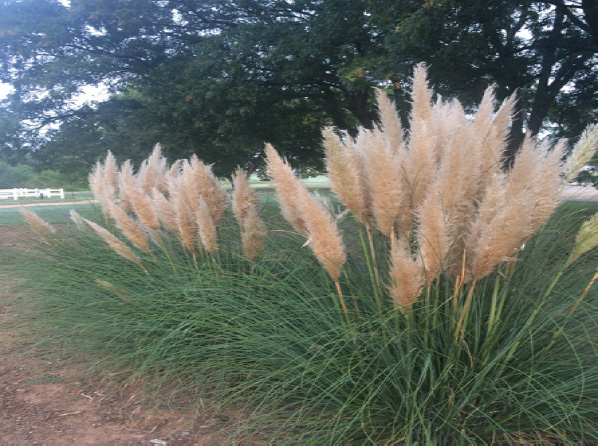 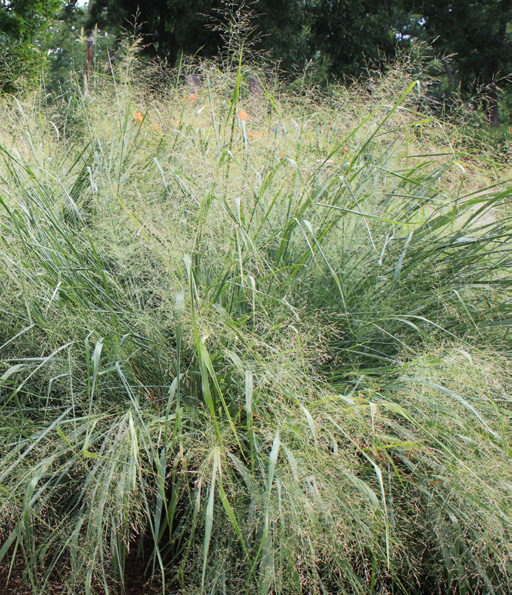 |
Plants for Erosion Control
Andropogon ternarius, split beard bluestem
Carex flacca, blue sedge
Eragrostis trichodes, sand lovegrass
Leymus arenarius, blue lymegrass
Liriope spp., lilyturf
Miscanthus sacchariflorus, silver banner grass
Molinia caerulea, purple moor grass
Phalaris arundinacea, ribbon grass
Sorghastrum nutans, Indian grass
Spartina pectinata, cordgrass
| Figure 8.1 and 8.2. Blue Dune lyme grass, Leymus arenarius ‘Blue Dune’. |
|---|
 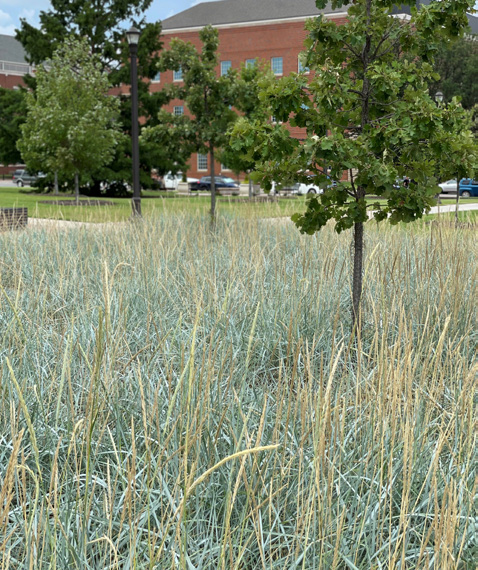 |
Plants that Self-seed
Andropogon spp., bluestem
Bouteloua hirsuta, hairy grama grass
Carex spp. (some), sedges
Chasmanthium latifolium, northern sea oats
Eragrostis spectabilis, purple lovegrass
Eragrostis trichodes, sand lovegrass
Festuca spp., blue fescue
Elymus hystrix, eastern bottlebrush
Melinis nerviglumis, ruby grass (annual)
Miscanthus sinensis cultivars, maiden grass: two or more cultivars can cross-pollinate and set seed
Molinia caerulea ssp. arundinacea, tall purple moorgrass
Nasella tenuissima, Mexican feather grass
Panicum virgatum, switchgrass
Pennisetum alopecuroides, fountain grass
Elymus canadensis, Canada wildrye
Schizachyrium scoparium, little bluestem
Sorghastrum nutans, Indian grass
Sporobolus heterolepis, prairie drop seed
Tripsacum dactyloides, eastern gamagrass
| Figure 9.1 and 9.2. Mexican Feather grass, Nassella tennuissima. |
|---|
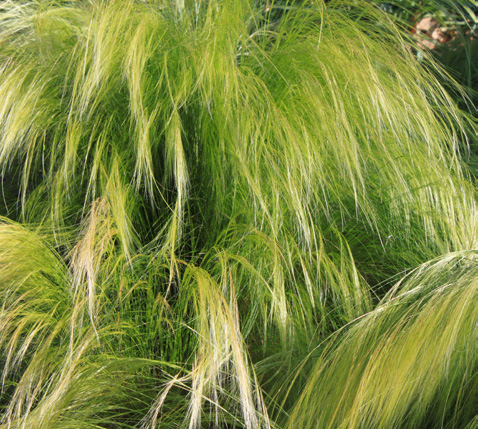 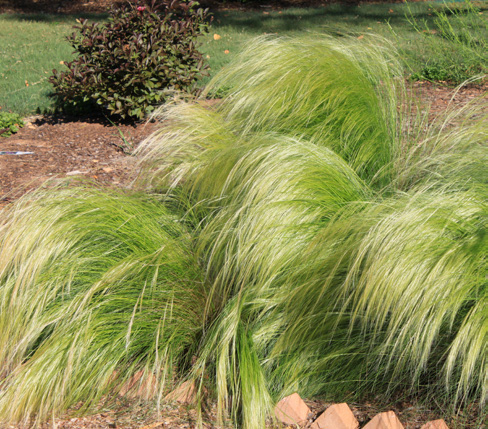 |
Plants for Hot and Dry Locations
Andropogon gerardii, big bluestem
Bouteloua curtipendula, side oats grama
Bouteloua gracilis, blue grama
Carex, sedges (certain spp.)
Elymus hystrix, bottlebrush grass
Eragrostis spp., lovegrass
Festuca glauca, blue fescue, most cultivars
Helictotrichon sempervirens, blue oat grass
Helictotrichon sempervirens ‘Saphiresprudel’, Saphiresprudel oat grass
Hordeum jubatum, foxtail barley, squirrel-tail grass
Imperata ‘Red Baron’, bloodgrass
Leymus arenarius, blue lyme grass
Melinis nerviglumis, ruby grass (annual)
Muhlenbergia capillaris ’Lenca’, Regal MistTM, pink muhly
Nassella tenuissima, Mexican feathergrass
Panicum virgatum, switch grass
Pennisetum orientale, oriental fountain grass (annual)
Pennisteum setaceum, fountain grass (annual)
Pennisetum villosum, feathertop (annual)
Phalaris arundinacea ‘Picta’, ribbon grass, reed canary grass
Tridens flavus, purpletop
| Figure 10.1 and 10.2. Hameln Dwarf Fountain Grass, Pennisetum alopecuroides ‘Hameln’ (left). Prairie dropseed, Sporobolus heterolepis (right). |
|---|
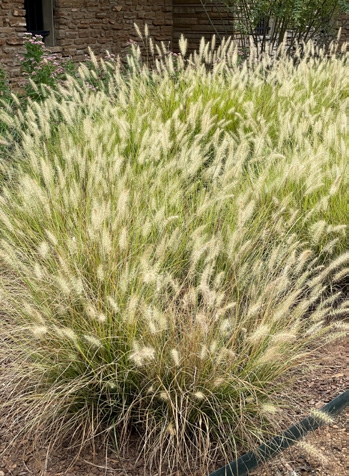  |
Plants for Prairie Restoration
Andropogon gerardii*, big bluestem; moderately to wet soils
Bouteloua curtipendula, side oats grama; dry to moderately moist soils
Bouteloua gracilis, blue grama; dry soil
Buchloe dactyloides, buffalograss; dry soil
Elymus canadensis, Canada wildrye; moderately moist soil
Koeleria macrantha, june grass; dry to moderately moist soils
Panicum virgatum*, switchgrass; wet to moderately moist soils
Schizachyrium scoparium*, little bluestem; dry to moderately moist soils
Sorghastrum nutans*, Indian grass; moderately moist soil
Spartina pectinata, cord grass; wet to moderately moist soils
Sporobolus heterolepis, prairie dropseed; dry soil
Tripsacum dactyloides, eastern gamagrass
*Dominant in the Tall Grass Prairie
| Figure 11.1 and 11.2. Blue grama grass, Bouteloua gracilis ‘Blonde Ambition’ (left). Buffalograss, Buchloe dactyloides (right) |
|---|
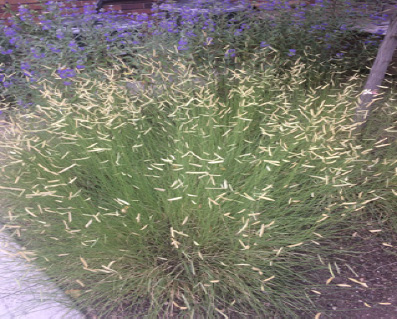 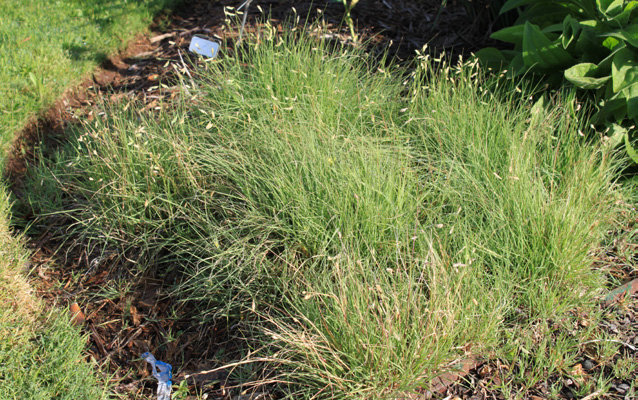 |
| Figure 12.1 and 12.2. Little bluestem, Schizachyrium scoparium. |
|---|
 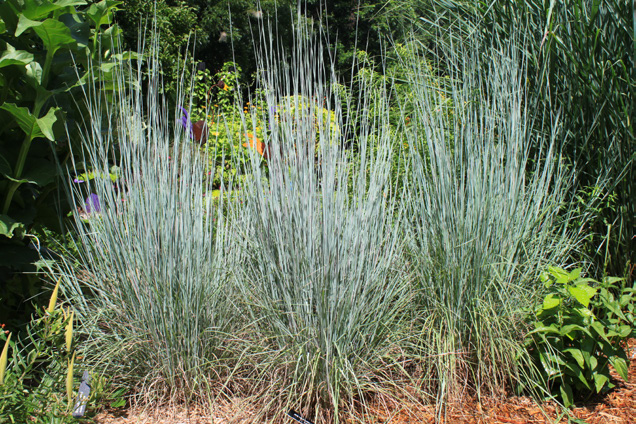 |
Alternative Plants for Lawn Grasses in Sunny Locations
Bouteloua curtipendula, side oats grama; 1-2'
Bouteloua gracilis, blue grama; 12-18"
Buchloe dactyloides, buffalograss; 6-12"
Carex pensylvanica, sun sedge; 12-18"
Carex flacca, blue sedge; 6-18"
Festuca glauca ‘Elijah Blue’, blue fescue; 6-12"
Koeleria macrantha, June grass; 12"
Sporobolus heterolepis, prairie dropseed; 2-3'
| Figure 13. Buffalograss, Buchloe dactyloides. |
|---|
 |
Alternative Plants for Lawn Grasses in Shady Locations
Carex spp., most sedges; 6"–2'
Hakonechloa macra, hakone grass; 6-18"
Hakonechloa macra ‘Albo-Striata’, striped hakone grass; 6-12"
Hakonechloa macra ‘Aureola’, golden hakone grass; 6-12"
| Figure 14. Ice Ballet variegated Japanese sedge, Carex morrowii ‘Ice Ballet’. |
|---|
 |
Plants with Fall Color* and Winter Interest
Andropogon gerardii, big bluestem ‘Blackhawks’- deep purple in fall, ‘Red October’ – deep red in fall
Calamagrostis x acutiflora ‘Karl Foerster’, feather reed grass - tan foliage, upright form
Calamagrostis brachytricha, fall blooming reed grass - pink- green fall flowers, tan foliage
Chasmanthium latifolium, northern sea oats - yellow fall color, brown seedheads last all winter
Festuca glauca ‘Elijah Blue’, Elijah Blue fescue - almost evergreen
Helictotrichon sempervirens, blue oat grass - almost evergreen
Miscanthus x ‘Giganteus’, giant miscanthus - tan foliage, winter sound and movement
Miscanthus sinensis, most cultivars - yellow or orange fall color, showy flowers in fall and all winter, usually upright in
winter; ‘Autumn Light’, ‘Gracillimus’, and ‘Morning Light’ are the stiffest cultivars
Miscanthus sacchariflorus, silver banner grass - good orange fall color, showy white flowers fall apart in December
Molinia caerulea ssp. arundinacea, ‘Skyracer’, and ‘Windspiel’, tall purple moorgrass - all tall cultivars are similar in fall: yellow stems and foliage, usually become prostrate with snow
Panicum virgatum, switchgrass - tan foliage, upright form in winter
Schizachyrium scoparium, little bluestem - orange fall and winter color, silvery fall flowers
Sorghastrum nutans, Indian grass - yellow and orange fall color, upright attractive flowers in winter
Spartina pectinata, cordgrass - yellow fall color
Spartina pectinata ‘Aureomarginata’, variegated cordgrass - yellow fall color
Spodiopogon sibiricus, silver spike grass - orange, red and bronze fall color; prostrate in winter
Sporobolus heterolepis, prairie dropseed - orange fall color
*Fall color can wane in winter months. See tables for additional cultivar listings.
| Figure 15.1, 15.2, 15.3 and 15.4. Pink Muhly grass, Muhlenbergia capillaris (first). Winter Interest - Bushy Bluestem, Andropogon glomeratus (second). Little bluestem, Schizachyrium scoparium (third). Ornamental grass garden in winter (fourth). |
|---|
  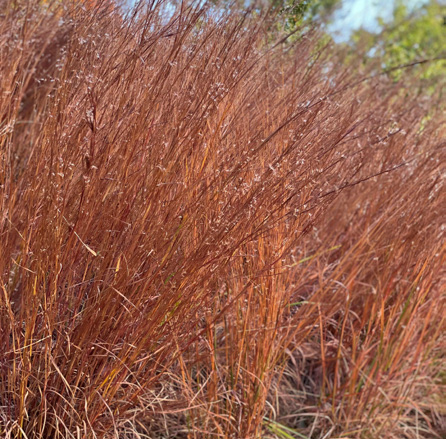 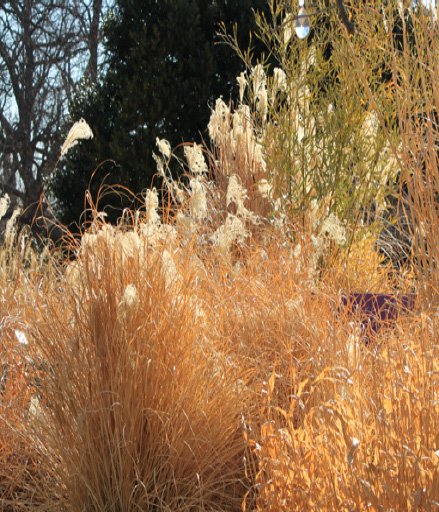 |
Table 1. Perennial Grasses:
| Scientific name Common name | Height | Light | Foliage | Flower | Comments |
|---|---|---|---|---|---|
|
Andropogon gerardii big bluestem* |
4-6' | Sun | Gray-blue-green | Purplish-red | Reddish bronze winter color. Larval host for butterflies. Tolerates all soils; prefers dry, infertile soil. Cultivars – ‘Blackhawks’, ‘Dancing Wind’, ‘Red October’, Windwalker®. |
|
Andropogon glomeratus bushy bluestem* |
1-2' | Sun to light shade | Green | White | Fluffy plumes. Flower spikes turn warm orange and leaves purplish in fall. Cottony plumes are quite attractive especially when backlit by sun. Grows best near water, along streams, and in bogs. Can reseed readily and be invasive under ideal conditions. |
|
Andropogon ternarius split beard bluestem* |
1-1.5' | Sun to light shade | Green to green with purplish tint | Silvery to creamy | Fluffy, cottony plumes. Flower spikes reach 4-5’ tall. Good erosion control and slope plant in poor or sandy soils. Grows best in well-drained soil. Great for fresh flower arrangements. Can reseed readily and be invasive in moist climates, not invasive in dry western climates. |
|
Arundo donax giant reed grass |
14' | Sun | Gray-green | White | Moist, well-drained soil. Nuisance to invasive under some conditions. ‘Variegata’- Variegated giant reed grass has creamy stripes in leaves. |
|
Bouteloua curtipendula side oats grama* |
18-24" | Sun | Gray-green | Purplish-tan | Slender, oat-like flowers point to one side. Fall foliage and flowers turn rich shades of orange and bronze. Any soil, drought tolerant. Food for wildlife. |
|
Bouteloua dactyloides buffalograss* |
4-6" | Sun | Gray-green | Not showy | Prefers slightly clayey soil. Drought tolerant. Can be used as turfgrass. Cultivars: ‘Bowie’, ‘Cody’, ‘Sundancer’, ‘609’, ‘Prairie’, ‘Prestige’, ‘Legacy’. |
|
Bouteloua gracilis blue grama* |
8-30" | Sun | Blue-green | White, blonde | “Eyelash” seed heads. Sand or clay soil. Accent, filler, lawns, massing. Great for western Oklahoma. Cultivars - ‘Blonde Ambition’ and ‘Hachita’. |
|
Bouteloua hirsuta hairy grama grass* |
8-12" | Sun | Green | White | Small native with eyelash-like blooms in summer. Drought tolerant. Will reseed and naturalize. Deer resistant. |
|
Calamagrostis x acutiflora feather reed grass |
1.5-4' | Sun to light shade | Green | Pink to beige | Good for vertical accent. Erect, slender, wiry stems; purplish plumes to 5’ high. Tolerates variety of soils. Cultivars - ‘Avalanche’, ‘Eldorado’, ‘Karl Foerster’, ‘Overdam’. |
|
Calamagrostis arundinacea foxtail grass, fall blooming reed grass, Korean feather reed grass |
3-4' | Sun to light shade | Green | Pink tinged then light tan | Pinkish plumes. Foliage yellowish beige in fall. Grows in average to wet soils, even heavy clay. Does not like to dry out. |
Table 1. Perennial Grasses:
(Continued)
| Scientific name Common name | Height | Light | Foliage | Flower | Comments |
|---|---|---|---|---|---|
|
Chasmanthium latifolium * Northern sea oats, inland sea oats, Indian wood oats, river oats |
2-3' | Part sun to shade |
Green; green/ cream |
Green-pink then golden | Seed heads look like fish on a string. Tolerates moist to wet soil. Self-seeding in moist soil. Cultivars – ‘Little Tickler’ and ‘River Mist’. |
|
Cortaderia selloana pampas grass |
8-12’ | Sun | Green | White, pink | Hardy and evergreen in southern borders of Oklahoma. Plumes appear in summer. ‘Pumila’ is a dwarf form (3-5’) and hardier than species; plumes are sterile. Can be aggressive in southern Oklahoma. |
|
Elymus canadensis Canada wildrye* |
2-4' | Sun or part shade | Green | Green | Cool-season, short-lived grass. A good bunchgrass for partly shady prairie plantings. Displays heavy, whiskery, nodding seed heads in early fall. Prefers a moist soil. Can take half a day of shade. The awns (seed husks) of this species are barbed and pose a serious threat of injury to pets. Self-seeds. |
|
Elymus hystrix bottlebrush grass* |
1-3’ | Sun, part shade | Green | Green | Bottlebrush-like seed heads. Adaptable to a wide range of conditions including clay, sand and rich garden soils. Will grow where many other grasses will not including dry shade. |
|
Eragrostis elliottii Elliott’s lovegrass* |
2-3’ | Sun | Blue-green | White to tan | Grows in sandy, low-nutrient soils; drought tolerant once established. Good for rain gardens. Cultivars: ‘Wind Dancer’. Note: non-native weeping lovegrass (E. curvula) is considered invasive and should be avoided. |
|
Eragrostis spectabilis purple lovegrass* |
1-2’ | Sun | Green | Purple | Soft reddish-purple flowers in a loose, open inflorescence form airy cloud. Any soil but prefers dry sandy or gravelly soil. Self-seeds, best in masses or naturalized settings. Good in masses or meadow-type plantings. Note: non-native weeping lovegrass (E. curvula) is considered invasive and should be avoided. |
|
Eragrostis trichodes sand lovegrass* |
2-4’ | Sun | Green | Purple tinted | Grows in average, dry to medium moisture, well-drained soil. Very drought tolerant. Will self-seed in optimum conditions. Plants turn bronze in fall. Good for naturalizing and erosion control. Note: non-native weeping lovegrass (E. curvula) is considered invasive and should be avoided. |
|
Erianthus contortus bent-awn plumegrass |
1.5-2’ | Sun to light shade | Blueish green | Purple | Southeastern native with bluish green foliage. In fall foliage turns stunning shades of red and purple. Striking foliage and flowering accent. Plumes emerge silky purple and become fluffy and cottony with age. Narrow, upright habit. Grows best in well-drained soil in full sun, though it tolerates dry soil and light shade. |
|
Erianthus ravennae ravenna grass, hardy pampas grass |
4-5’ | Sun | Gray-green | Silvery with purple |
Foliage turns shades of orange, beige, tan, brown and purple often with multiple colors blended. Plumes mature to fluffy, cream-colored panicles that persist into winter.
Great accent plant or screen. Plumes are used in cut/dried flower arrangements. Prefers moist, well-drained soil, but considerably drought tolerant. |
|
Festuca glauca blue fescue |
0.5-1’ | Sun to part shade | Blue-gray | Not showy | Cool-season, bunch grass. Needs well-drained soil. Cultivars – ‘Beyond Blue’, ‘Blue Whiskers’, ‘Boulder Blue’, ‘Elijah Blue’, ‘Golden Toupee’, ‘Sea Urchin |
Table 1. Perennial Grasses:
(Continued)
| Scientific name Common name | Height | Light | Foliage | Flower | Comments |
|---|---|---|---|---|---|
|
Hakonechloa macra Japanese forest grass |
1-1.5' | Part shade | Green to gold to variegated; copper-orange shades in fall | Not showy | Clump forming plant with arching stems. Prefers moist, well-drained soil. Protect from late afternoon sun and winds. Cultivars - ‘Albostriata’, ‘Aureola’, ‘All Gold’, ‘Beni-kaze’, Sunflare™. |
|
Helictotrichon sempervirens blue oat grass |
2-3’ | Sun | Blue | Bluish-brown | Graceful nodding flowers on arching stems. Grows in average, dry to medium, well-drained soil. Crown rot may occur in moist, poorly drained soil. Best blue color occurs in dryish soils. Remove withered leaves as they appear. Cool-season grass, evergreen. |
|
Hordeum jubatum foxtail barley, squirrel-tail grass |
1-2' | Sun |
Green to blue-green |
Pale green to purplish | Short-lived perennial. Nodding clusters of purple to pale green flowers with many long, straight bristles. Wet to dry conditions. |
|
Imperata brevifolia satintail* |
1-1.5’ | Sun or shade | Green | Satiny white | Creeping, warm-season grass that has attractive red fall color and cottony white plumes. Foliage a translucent bright green that becomes red as the season progresses. Good for naturalizing along streams or ponds. Best planted in masses. Good for pots or other containers. Prefers moist, well-drained soil in full sun or part shade. It flowers less and does not develop good fall color in considerable shade. Tolerates heat if moisture is present. |
|
Imperata cylindrica ‘Red Baron’ Japanese blood grass |
1.5' | Sun |
Red/ green |
Rarely flowers | Leaves green at base, with red tips. Slowly forms a clump. Prefer moist, but well-drained soil. Weedy if not monitored. Remove all green shoots that appear. ‘Red Baron’/‘Rubra’ is a shorter, less invasive horticultural selection that reportedly rarely flowers, does not set seed and lacks the invasive spreading tendencies attributed to the species. |
|
Koeleria macrantha (K. pyramidata) prairie junegrass, hairgrass |
1.5-2’ | Sun | Green | Amber | Cool-season, clump forming. Thrives in rocky or gritty soils. Needs superior drainage. Tolerates drought. Avoid wet and/or heavy soils or shade. |
|
Leymus arenarius blue lyme grass |
3' | Sun to light shade | Blue | Beige | Cool-season grass tolerant of hot weather. Prefers dry, sunny locations; very salt tolerant. ‘Blue Dune’ is a bright blue form. Spreads by rhizomes, use as a ground cover and erosion control. |
|
Miscanthus silver grass, maiden grass, eulalia grass |
3-10’ | Sun to light shade |
Green/ White |
White, pink, red | Popular grass with graceful, vase-shape, and soft, airy texture. Easy to grow. Great year-round interest. Genus consists of many species and cultivars. See Table 4 for various species and cultivars. |
|
Molinia caerulea purple moor grass |
1.5-3’ | Sun to light shade | Green | Yellow | Dense, upright growth. Grows best in average to moist soils and make a great rain garden grass. Attract birds, good for erosion control. Deer resistant. Cultivars – ‘Bergfreund’, ‘Heidebraut’, ‘Moorflamme’, ‘Moorhexe’, ‘Skyracer’, ‘Transparent’, ‘Variegata’, ‘Windspiel’. |
Table 1. Perennial Grasses:
(Continued)
| Scientific name Common name | Height | Light | Foliage | Flower | Comments |
|---|---|---|---|---|---|
|
Muhlenbergia capillaris * pink muhly grass |
2-4' | Sun | Gray-green to blue-green | Pink | Plumes pinkish panicles and cloud-like. Best in sandy, rocky, well-drained soil. Cultivars: ‘Fast Forward’, ‘Lena’ (Regal Mist®), ‘Pink Cloud’, ‘Pink Flamingo’, ‘White Cloud’ (white flowers). |
|
Nasella tenuissima * Mexican feather grass |
1-3' | Sun | Green | Silky, golden | Very fine texture. Drought tolerant. Readily self-seeds; can be aggressive. |
|
Panicum virgatum * switch grass |
4-6’ | Sun to part shade | Green | White, pinkish | Graceful, arching foliage; usually blue-green in summer turning yellow-orange in fall. Dry to wet soil, prefers moist sandy, clay. Great for accent, screens, borders, massing. Cultivars – ‘Cheyenne Sky’, ‘Cloud Nine’, ‘Dallas Blues’, ‘Haense Herms’, ‘Heavy Metal’, ‘Northwind’, ‘Shenandoah’, ‘Totem Pole’. |
|
Pennisetum alopecuroides fountain grass |
1-5' | Sun to light shade | Green | Reddish cast |
Showy bottle brush-like flower spikes in summer. Grows in medium to wet soils. Drought tolerant. Occasionally weedy.
Cultivars – ‘Cassian’, ‘Desert Plains’, ‘Foxtrot’, ‘Hameln’, ‘JS Jommenik’, ‘Little Bunny’, ‘Moudry’, ‘Red Head’. |
|
Pennisetum orientale oriental fountain grass |
1-3’ | Sun to part shade | Green or gray-green | Pinkish | Best in moist, well-drained soil; drought tolerant. Seldom self-sows. Specimen or mass plantings, great for edgings. Cultivars – ‘Karley Rose’ and ‘Tall Tails’ (5’ high) |
|
Phalaris arundinacea ‘Picta’ ribbon grass, reed canary grass |
2-4’ | Sun |
White/ green |
Greenish-white to pale pink | Best color contrast between cream and dark green stripes. Wet or dry soils. Aggressive spreader by rhizomes, less aggressive in drier areas. Cultivars - ‘Strawberries n Cream’ (‘Feesey’) is blushed with pink. |
|
Schizachyrium scoparium * little bluestem |
2-4’ | Sun to part sun | Bluish | Green | Strict, upright habit. Salmon/copper fall color. Any soil, except wet or boggy; drought tolerant, thrives on neglect. ‘Blaze’, Blue Heaven®, ‘Carousel’, ‘Jazz’, ‘Prairie Blues’, ‘Smoke Signal’, ‘Standing Ovation’, ‘The Blues’, ‘Twilight Zone’. |
|
Sorghastrum nutans Indian grass |
3-6’ | Sun to part sun | Blue-green | Golden | Official state grass. Upright with stiff, vertical flowering stems. Foliage turns yellow, then orange in fall. Accent or massing, erosion control, wildlife habitat. Any soil. |
|
Spartina pectinata ‘Aureomarginata’ golden-edged prairie cord grass* |
3-6’ | Sun to light shade |
Green/ yellow |
Straw colored | Yellow-edged, green leaves; fall color clear yellow. Best in moist, fertile soil in full sun to partial shade. It is an aggressive grass, spreading by rhizome and by seed, not suited to small gardens. It will tolerate less fertile, rocky, dry soils where it will be less aggressive. Tolerates wet soils. |
|
Spodiopogon sibiricus frost grass |
3-5’ | Sun to part shade | Green | Purple to tan | Bamboo-like quality. Leaves display purplish to wine tints in fall. Medium to wet soils; does poorly in hot dry sites. |
Table 1. Perennial Grasses:
(Continued)
| Scientific name Common name | Height | Light | Foliage | Flower | Comments |
|---|---|---|---|---|---|
|
Sporobolus heterolepis prairie dropseed* |
2-3’ | Sun | Green |
Green/ pink/ copper |
Fine texture with arching form. Golden with orange hues in fall. Airy flower and seed heads. Slow growing. Average to well-drained soil, tolerates clay. Ground cover, meadows, rain garden. Cultivar – ‘Tara’. |
|
Sporobolus wrightii, giant sacaton |
3-6’ | Sun | Green | Yellow | Narrow, arching foliage with showy plumes. Drought, salt, and alkaline tolerant Southwest native. ‘Windbreaker’ gets 8-10’ high. |
|
Tridens flavus purpletop |
3-6’ | Sun to part shade | Green | Purple | Drooping branches bearing widely spaced reddish-purple spikelets. Prefers dry soils. Drought and salt tolerant. larval host to skippers. Especially impactful when planted en masse. |
|
Tripsacum dactyloides Eastern gamagrass |
4-8’ | Sun to part shade | Green | Purple (female) and Orange (male) | Robust, clump-forming, native grass. Leaves coarse, arching. Monoecious. Easily grown in average to medium, well-drained soil. Naturalizes by thin, creeping rhizomes and self-seeding. |
|
Uniola paniculata seaoats |
4-6’ | Sun | Green | White | Panicles have attractive drooping seed heads that can be used in dried arrangements. Grows in sandy soils and tolerant of drought, salt, and brief flooding. |
|
Zoysia spp. zosyiagrass |
6-12” | Sun to light shade | Green | Not showy | Zosyiagrass is a cold hardy, warm-season turfgrass with medium to fine texture. Left unmowed, it makes a soft green, wispy groundcover. |
Table 2. Annual or Tender Perennial Grasses:
| Scientific name Common name | Height | Light | Foliage | Flower | Comments |
|---|---|---|---|---|---|
|
Agrostis nebulosa cloud grass |
1.5' | Sun | Green | White | The airy seed-heads resemble clouds or sea foam. Great for flower arrangements. Suitable for meadow setting. Average to good soil. |
|
Briza minor little quaking grass |
1' | Sun | Green | Light green to reddish brown. | Dangling spikelets that tremble and dance in the wind. |
|
Briza maxima large quaking grass |
1.5’ | Sun | Green | Light green to reddish brown | Oat-like, light green spikelets in late spring and summer. Spikelets tremble and dance in the wind. Well-drained soil, but tolerant of poor soils. Good for dried arrangements. |
|
Cymbopogon citratus lemon grass |
2-4’ | Sun |
Light green |
Not showy | Attractive, dense rounded clump with gracefully arching leaves. Leaves emit a lemony fragrance when bruised. Extracted plant oils have been used for many years in herbal medicines and perfumes. Grows easily in average to medium, well-drained soil. |
|
Lagurus ovatus hare’s-tail grass or bunny tail grass |
1-2’ | Sun | Green | White | Soft, narrow leaves form clumps. Whitish spike-like oval flower clusters are soft with hairy awns (bristles) that appear furry. Good cut flower. Grow in a container, border or in mass plantings. Average to light soil. Drought tolerant. |
|
Melinus nerviglumis ruby grass |
1.5-2’ | Sun to part shade | Blue-green | Pink | Blue green foliage and ruby-pink blooms with glistening silky hairs in late spring. Flowers retain their color even when dried and may be used for cut-flower arrangements. Excellent in beds, borders and is spectacular in a container planting. Well-drained soil. Cultivars: ‘Pink Champagne’, Pink Crystals™, ‘Savannah’. |
Table 2. Annual or Tender Perennial Grasses:
(Continued)
| Scientific name Common name | Height | Light | Foliage | Flower | Comments |
|---|---|---|---|---|---|
|
Pennisetum purpureum hybrids & cultivars napier or elephant grass (fountain grass) |
4-6’ | Sun | Purple | Yellow-brown | Rapid-growing, clump-forming grass with upright arching, narrow, linear, leaves. Medium moisture, well-drained soils. Can be overwintered in greenhouse or indoors. Cultivars: ‘First Knight’, ‘Prince’, ‘Princess Caroline’, Vertigo®. |
|
Pennisetum setaceum fountain grass |
3’ | Sun | Green | Purple | Blooms all summer until frost; provides dramatic accent in sunny beds and borders, with purple leaves and bristled flower spikes providing color and texture throughout the season. Moist, well-drained soil. Heat and drought tolerant plant. Cultivars: ‘Cherry Sparkler’, ‘Fireworks’, ‘Rubrum’. |
|
Pennisetum glaucum ornamental millet |
2-5’ | Sun | Green to maroon to deep purple | Red-purple | Upright bunch habit. Selected for their attractive foliage and inflorescences. Inflorescences are foot-long bottle brush-like on the ends of the stems. The “fruits” that follow are cylindrical white, yellow, brown or purple. Best in light, well-drained soils, but most selections tolerate almost any type of soil. Drought tolerant. Vertical accent plant, best in clumps or masses. Cultivars: ‘Jade Princess’, ‘Purple Barron’, ‘Purple Jester’, ‘Purple Majesty’. |
|
Pennisetum villosum feathertop grass |
2’ | Sun | Light green | White | Graceful with its large, fluffy, bright white flower plumes. Best in full sun in average, well-drained soil. |
|
Setaria palmifolia palm grass or highland pitpit |
6’ | Sun to light shade | Green | Tropical, lush plant with palm-like coarse leaves. Average water. | |
|
Stenotaphrum secundatum ‘Variegatum’ variegated St. Augustinegrass |
6-8” | Sun to light shade | Green and white | Not showy | St. Augustinegrass is a warm-season, coarse textured turfgrass for the very southern regions of Oklahoma. Variegated St. Augustine can be grown as an annual ornamental groundcover or in containers where it can spill over the edge. |
Table 3. Grass-Like Species:
| Scientific name Common name | Height | Light | Foliage | Flower | Comments |
|---|---|---|---|---|---|
|
Acorus gramineus Japanese or grassy-leaved sweet flag |
.5-1’ | Shade |
Green/ golden |
Semi-evergreen groundcover. Grows well in many conditions including wet, boggy sites and prefers damp soil. This plant can handle up to 4 inches of standing water; it does not perform well in dry soils. Cultivars: ‘Ogon’ – more tolerant of sun than other Acorus, but will look better with afternoon shade, ‘Mininus Aureus’, ‘Oborozuki’, ‘Variegatus’. | |
|
Carex spp., sedges |
.5-3’ | Sun to shade | Various | Various | Many types; natives often found growing in wetland areas. See Table 5 for list of species and cultivars. Some are possible lawn substitutes for shady areas. |
|
Cordyline spp. and cultivars cordyline or Ti plant |
2-4’ | Full sun to part shade | Green, red, yellow, white, purple, and purplish-red | White, pink, lavender | Long spikey, leathery leaves in a variety of colors. Often grown as a houseplant, treated as an annual in Oklahoma. Well-drained soils. Cultivars – many. |
|
Cyperus involucrata umbrella plant or umbrella sedge |
3-6' | Sun to part shade | Green | Green turning reddish-brown | Grown for its showy whorl-like cluster of 10-25 thin slightly downward-arching leaf-like bracts, which form a showy umbrella-shaped rosette. Grows in wet, boggy soils. Tender perennial (Annual). Cultivars: Baby Tut®. |
|
Cyperus papyrus papyrus or paper plant |
5-8’ | Sun to part shade | Green | Greenish-brown | Grown for stems topped by an umbellate inflorescence of 100+ narrow arching thread-like rays. Grows in wet, boggy soils. Tender perennial (Annual). Cultivars: King Tut®, Prince Tut™. |
|
Equisetum hyemale scouringrush or horsetailrush* |
2-4’ | Sun to part shade | Green | Features rough, vertically ridged, jointed-and-segmented, bamboo-like, dark green stems. Evergreen. Grow in medium to wet soils. Good plant for covering a wet low spot where nothing else will grow. Interesting plant for large patio containers. Native, but very aggressive spreader, plants should be physically contained to avoid spread. |
Table 3. Grass-Like Species:
(Continued)
| Scientific name Common name | Height | Light | Foliage | Flower | Comments |
|---|---|---|---|---|---|
|
Juncus effusus common or soft rush* |
2-4’ | Sun or shade | Blue to blue-green | Yellowish-green | Smooth, upright, cylindrical, unjointed, spire-like green stems, which grow in spreading basal clumps. Cut back old foliage in early spring. Easily grown in moist to wet soils. Cultivars: ‘Quartz Creek’, ‘Spiralis’ (corkscrew rush) acts as an annual in normal landscape soils. |
|
Juncus inflexus hard rush or blue rush |
1-3’ | Sun | Blue-green | Straw to reddish-brown | Upright, cylindrical, blue-green stems/leaves. Grows in consistently moist to wet soils. Thrives in neutral to alkaline soils. Good for water gardens, ponds, boggy areas. Cultivars: ‘Afro’ (Blue Medusa), ‘Blue Arrows’, ‘Blue Dart’, Blue Mohawk®. |
|
Libertia species New Zealand iris |
1-3’ | Sun to light shade | Green, blue-green, golden, bronze, orange | White | Swordlike leaves provide a spiky, modern look to the garden. Produces orchid-like, 3-petalled flowers aloft stiff stems. Well-drained soils with reliable moisture. Spreads slowly from rhizomes. Treated as an annual, hardy to zone 8 or warmer. |
|
Liriope muscari big blue lilytur |
1-1.5’ | Shade or sun | Dark green, variegated | Lavender, purple, pink or white | Evergreen mounds of grass-like foliage. Grows in clumps and is slow to spread making it good for edging. Grow in deep shade or full sun, sand, or clay. It can endure heat, drought, and salt spray, but will not take “wet feet”; it requires moist, well-drained soil. Mow off the foliage in late winter before growth starts with a lawn mower set at the highest possible cutting height. Be sure not to injure the crown of the plant. Cultivars – many. |
|
Liriope spicata creeping lilyturf |
1-1.5’ | Shade or sun | Dark green, variegated | Lavender, purple, pink or white | Evergreen mounds of grass-like foliage. Spreads rapidly and will cover large areas making it good as an erosion control groundcover; can be aggressive. Grow in deep shade or full sun, sand or clay. It can endure heat, drought and salt spray, but will not take “wet feet”; it requires moist, well-drained soil. Mow off the foliage in late winter before growth starts with a lawnmower set at the highest possible cutting height. Be sure not to injure the crown of the plant. Cultivars – many. |
Table 3. Grass-Like Species:
(Continued)
| Scientific name Common name | Height | Light | Foliage | Flower | Comments |
|---|---|---|---|---|---|
|
Luzula species woodrush* |
4-18” | Sun to shade | Green | White to yellow green | Leaves are edged or covered with hairs. Some species have showy flowers. Typically found in moist woodland areas though some are dry shade tolerant. Cultivars with chartreuse and variegated foliage are available. |
|
Nolina greenei woodland or Green’s beargrass* |
30-36” | Sun | Green | White with purple midveins | Native to western states and panhandle of Oklahoma. Grows in rocky locations and in grasslands or pine-oak woodlands but is adaptable to various soils. Long narrow, evergreen leaves sometimes with sharp teeth along margins. Drought resistant. Attracts butterflies. |
|
Nolina texana beargrass* |
3' | Sun to part shade | Green | Creamy white | Long slender leaves with smooth margins and a weeping habit. Drought tolerant. Attracts butterflies. |
|
Ophiopogon japonicus mondograss |
2-16” | Part sun to full shade | Dark green | White | Tufted, grass-like, evergreen clumps. Great for groundcover, as a border, or between steppingstones. Grows well in ordinary garden soil, requiring minimum attention once established. Cultivars: ‘Gyoku Ryu’, ‘Nana’, ‘Silver Dragon’, ‘Variegatus’. |
|
Ophiopogon planiscapus ‘Nigrescens’ black mondograss |
6-8” | Part sun to part shade | Blackish-purple | White with pink to lilac tint | Leaves appear almost black; black color is best in full sun. Grows in slow spreading clumps. Best in moist, slightly acidic, well-drained soil. May be sold as ‘Arabicus’, ‘Black Dragon’, or ‘Ebony Knight’ but are considered synonymous. |
|
Phormium tenax New Zealand flax |
1-6’ | Sun to part shade | Bronze, purple, red-orange, green, variegated | Dark red | Stunning focal point. Rigid, sword-shaped leaves. Grow in average, medium moisture, well-drained soil. Treated as an annual. Cultivars: ‘All Black’, ‘Amazing Red’, Dark Delight’, ‘Duet’, ‘Guardsman’, ‘Mat’s Merlot’, ‘Platt’s Black’, ‘Sundowner’, ‘Variegatum’, ‘Yellow Wave’. |
|
Schoenpolectus tabernaemontani great bulrush, soft-stem bulrush* |
3-9’ | Sun | Green | Brown | Thrives in wetlands. Can spread aggressively under ideal conditions. Grow in submerged containers. Cultivar: ‘Zebrinus’ (Zebra rush, banded bulrush). |
|
Sisyrinchium angustifolium narrow-leaf blue-eyed-grass* |
1-1.5’ | Sun, part shade | Green | Blue, deep blue-violet, white | Meadows; damp fields; low, open woods. This short-lived perennial will decline if allowed to dry out. Heavy mulch causes crown rot and rich, organic soils encourage rank, vegetative growth. Plants need to be divided at least every other year. |
Table 4. Miscanthus Species/Cultivar List
| Species
|
Leaf Color | Flower Color | Height | Comments |
|---|---|---|---|---|
|
M. floridulus Pacific Island silvergrass or giant miscanthus |
Green | Pink-tinged | 8-10’ | Large grass for large areas. Tolerant of wide range of soils including heavy clays and wet soils; tolerant of hot, humid summers. Purple tints on foliage in fall. |
|
M. x giganteus giant silver grass |
Green | Red | 9-12’ | 1” wide foliage; October flowers; huge plant; slightly rhizomatous. Often listed incorrectly as Miscanthus floridulus. |
|
M. oligostachyus small Japanese silver grass |
Green | Pinkish-silver | 2-4’ | Tolerant of wide range of soils. Prefers moist soils and full sun. Thin flowers; rhizomatous with age; leaves turn bronze-red in fall. Part shade tolerant. |
|
M. ‘Purpurascens’ flame grass |
Green | Red tinged to white-beige | 5-5.5’ | Very hardy; drought sensitive; best in full sun. Leaves with reddish tinge, with red-orange fall color. |
|
M. sacchariflorus amur silver grass, silver banner grass |
Blue-green | Silver to white | 6’ | Invasive rhizomes in wet areas; can reseed itself. Grows in moist to wet soils and best in full sun; flowers fall apart early. Leaves turn yellow in autumn. |
|
M. sinensis var. condensatus |
Green | Red-gold | 6’ | 1-2” leaves; full sun to part shade; moist soils, tolerant of clay soils. A large plant native to coastal southern Japan; dense flowers. |
|
‘Cabaret’* |
Green/creamy white | Copper to creamy white | 4-6’ | Arching, showy foliage; leaves with wide creamy white center, dark green margins. May revert to green. |
|
‘Cosmopolitan’* |
Green/ creamy white |
Coppery-pink | 6-10’ | Showy foliage; broad green midrib with creamy margins. Like M. sinensis ‘Variegatus’ but has wider leaves and a more erect habit; tendency to revert back to green. |
|
M. transmorrisonensis |
Green | Creamy to silver | 2-4’ | Short; can be evergreen; tropical origin in Japan. Narrow green leaves. Inflorescence makes good cut flower. Grows wide to 6-8’. |
|
M. sinensis cultivars: |
||||
|
‘Adagio’ |
Green/white | Pink-gold | 5-6’ | Fine–textured; short; similar to ‘Yaku Jima’. May spread through seed. |
|
‘Autumn Light’* |
Green | Red | 6’ | Upright to mounding; showy red flowers. Leaves turn yellowish with purple tinges in fall before fading to tan. |
|
‘Blondo’ |
Green/ white |
Yellow-gold | 6-6.5’ | Yellow fall foliage and stems; may lodge and self-seed. |
|
‘Bluetenwunder’ (Flower Wonder) |
Green | White-gold | 5’ | Graceful form. Full sun to bright shade, needs ample water. |
|
‘Dixieland’* |
Green/ white |
Red | 3-4’ | Slightly shorter than ‘Variegatus’. Colorful, good for smaller garden. Wide green leaves with white stripes. |
Table 4. Miscanthus Species/Cultivar List
(Continued)
| Species | Leaf Color | Flower Color | Height | Comments |
|---|---|---|---|---|
|
M. sinensis cultivars (continued): |
||||
|
‘EMPMISO1’ Red Cloud® |
Green | Rose-gold | 3.5’ | Great for small gardens. Showy plumes. Adaptable to wide variety of soil conditions. |
|
‘Ferner Osten’ (Far East) |
Green/silver | Red | 4-5’ | Strong, compact grower; dark green foliage with bright silver midrib. Showy flowers; medium- to fine-texture. |
|
‘Fire Dragon’ |
Green | White | 6-7’ | Leaves turn intense red and orange in fall. Upright accent plant. |
|
‘Flamingo’ |
Green/white | Deep pink to white | 5-5.5’ | Flowers pink and slightly pendulous changing to silvery white. Foliage with prominent white midrib turns orange-gold shades in fall. |
|
‘Gold Bar’* |
Green/gold | Burgundy | 4-5’ | Dense, dramatic gold stripes (horizontal bands) on bright green foliage. Compact, upright habit. Great for adding texture to beds. Good in containers. |
|
‘Gold Breeze’* |
Green/gold | Yellow | 6’ | Arching habit. |
|
‘Goliath’ |
Green | Red | 8-9’ | Huge and coarse-textured. Broad, cascading leaves. Yellow fall color. |
|
‘Gracillimus’* |
Green/white | Copper red | 5-6’ |
Stiff and fine-textured; very graceful. Silver midrib on leaf. Foliage turns yellowish with first frost.
‘Gracillimus Nana’ is a dwarf form to 3-4’ high. |
|
‘Graziella’ (Graceful) |
Green | White-gold | 3-4’ | Nice, narrow green leaves form a rounded, arching clump. Showy flowers; good fall color. Like ‘Gracillimus’, except blades are more erect and overall height is shorter. |
|
‘Kaskade’ (cascade) |
Green | Pink-white | 5-6’ | Large, cascading. One of best summer blooming Miscanthus. |
|
‘Kirk Alexander’ |
Green/yellow | Light red | 3-4' | Shorter; horizontal banding of yellow, but less than ‘Zebrinus’ and more compact. |
|
‘Kleine Fontaine’ (Little Fountain) |
Green | Pink-white | 4-6’ | Early, continually developing flowers; upright, fountain-like appearance; medium texture; full sun. |
|
‘Kleine Silberspinne’ (Little Sliver Spider) |
Green | White-gold | 4-4.5’ | Small; fine-textured, upright habit, good for small gardens. |
|
‘Little Kitten’ |
Green | Cream white | 12-15” | Very small. Narrow green foliage. |
|
‘Little Miss’ |
Green | Red | 2-3’ | Foliage graduating from green to brilliant carmine and purple tones in summer, intensifying in fall. Foliage clumps retain their green coloration in the center, providing a delightful two-tone effect. |
|
‘Little Nickey’ (Hinjo) |
Green/gold | Red | 3-4’ | Dwarf form of ‘Zebrinus’ and twice as many horizontal bands. |
|
‘Little Zebra’ |
Green/ivory to yellow | White | 3-4’ | Arching blades with ivory to yellow bands. |
Table 4. Miscanthus Species/Cultivar List
(Continued)
| Species | Leaf Color | Flower Color | Height | Comments |
|---|---|---|---|---|
|
M. sinensis cultivars (continued): |
||||
|
‘Malepartus’ |
Green/white | Red | 6’ | Large showy flowers, good fall color; may self-seed. |
|
‘Morning Light’* |
Green/white | Red | 4-6’ | Tolerant of summer heat and humidity. Keeps upright shape better than other varieties. Beautiful form and texture. |
|
‘NCMS1’ My Fair Maiden™ |
Green | White | 6-8.5’ | Vase shaped with cascading leaves. Nearly sterile. Good for textural contrast, background plant. |
|
‘NCMS2B’ Bandwidth |
Green/yellow | Golden brown | 2.5-3’ | Rust-resistant foliage. Naturally narrow, upright, a wonderful accent for smaller gardens or in groupings in larger scale landscapes. Topped by airy golden-brown plumes in the fall. A non-invasive cultivar. |
|
‘Nippon’ |
Green | Beige | 4-5’ | Early flowers; red stems; good for smaller gardens. May self-seed. |
|
‘November Sunset’ |
Green | Red-gold | 6-8’ | Medium texture. Good specimen plant. Good yellow-orange fall color. Blooms in November. |
|
‘Positano’ |
Green | Red-gold | 5-6’ | Graceful habit, medium height and texture, red blooms, good fall color of reds and oranges. |
|
‘Puenklchen’ |
Green/yellow | Red | 5-5.5’ | Finer than and fewer bands than ‘Zebrinus’; similar to ‘Strictus’. |
|
‘Rigoletto’* |
Green/white | Light red | 5’ | Variegated foliage with white margins, like ‘Variegatus’ but slightly shorter and more compact. Excellent for smaller gardens. |
|
‘Roland’ |
Green | Pinkish-purple | 8-9’ | Large and coarse-textured; tall, large pinkish-purple blooms. |
|
‘Rotsilber’ (Red Silver) |
Green | Red-silver | 5-5.5’ | Very showy flowers. Good fall color. |
|
‘Sarabande’ |
Green/silver | Red | 5-6’ | Fine, silvery foliage, golden inflorescence. |
|
‘Silberfeder’ (Silver Feather) |
Green | Yellow-gold | 6-8’ | Beautiful, tall, sliver inflorescence high above foliage. Specimen, groups or good as screen. Large and coarse-textured. |
|
‘Silberpfeil’ (Silver Arrow) |
Green/white | Light red | 6-7’ | Very similar to ‘Variegatus’ – green and white variegated foliage with reddish plumes. |
|
‘Silberspinne’ (Silver Spider) |
Green | Red-gold | 5 – 6’ | Fine-textured; silvery flowers; graceful plant for the small garden. |
|
‘Silberturm’ (Silver Tower) |
Green | White-gold | 8-10’ | Good green foliage with large silver flowers. Coarse-textured. |
|
‘Strictus’* porcupine grass |
Green/yellow | Red-yellow | 5-6’ | Stiff; columnar; shorter leaves and more banding than ‘Zebrinus’. |
|
‘Tift M&&’ Scout™ |
Green | Pink | 5-6’ | Arching foliage becomes red in fall. Accent plant. Infertile and non-invasive. |
|
‘Undine’ |
Green | Golden-red | 5-7’ | Medium texture, tall, airy, fine and graceful; leaves with white midrib turn orange and straw colored in autumn. |
|
‘Variegatus’* |
Green/white | Red | 5-6’ | October flowers; arching rounded clump. may lodge when flowering. Green and white striped leaves with white being predominant color from a distance. |
|
‘Yaku Jima’ |
Green | Beige | 3-4’ | Short, fine-textured. Looks like dwarf ‘Gracillimus’ (improved form of ‘Adagio’). ‘Yaku Jima Dwarf’ is a compact form growing 2-3’ tall. |
|
‘Zebrinus’* |
Green/yellow | Red | 6-7’ | Long leaves; horizontal yellow zebra-like bands at irregular intervals. Clumps are rounded and tend to flop and may need support. |
* Miscanthus trials have indicated that cultivars marked with an asterisk are the better cultivars for being sterile or less weedy in nature.
Table 5. Carex Species and Cultivars
| Native Species | Height | Light | Foliage | Flower | Comments |
|---|---|---|---|---|---|
|
C. amphibola creek or eastern narrow-leaved sedge |
1-2’ | Shade to sun | Green | Not showy | Fountain shaped form. Attractive, shiny green leaves. Average to wet soil; in full sun it is best in consistently moist soil. Prefers shade and moist conditions. Found growing in deciduous forests. Semi-evergreen. Tends to reseed. |
|
C. appalachica Appalachian sedge |
1' | Morning sun to shade | Green | Not showy | Thin, fine-textured. Great groundcover for shade and heavy shade areas. Adaptable to a wide range of soils, including clay. Dry to average moisture. Mow high in early to mid-spring. Evergreen. Flowers provide nectar to native insects and seed to birds. |
|
C. bicknellii Bicknell’s sedge |
3' | Part sun to sun | Green | Copper | Bunching habit; more tolerant of dry soils than other Carex. Dry to wet soils. |
|
C. blanda common wood sedge |
.5-2’ | Shade to sun | Green | Green | Evergreen, extremely versatile. Moist to semi-dry conditions; tolerates wide range of soil types. Low mounding form. |
|
C. brevior short-beak sedge and plains oval sedge |
1' | Shade to sun | Green | Green | Commonly found in dry areas but adaptable to wetlands and seasonally flooded sights. Fruit is prickly oval spikes that turn golden brown in fall. Bunch form with short rhizomes. |
|
C. bromoides brome-like sedge |
.75-1’ | Part shade | Green | Light green to tan | Host plant for several native butterflies and moths, including the eyed brown (Satyrodes eurydice) and several species of skipper. The seeds are attractive to birds. |
|
C. cherokeensis Cherokee sedge |
.5-1’ | Part shade to sun | Green | Green | Bunching; spreads via short rhizomes; reseeds heavily; mostly evergreen. Average to wet soils. |
|
C. comosa bristly sedge, longhair sedge |
2-3’ | Part shade to sun | Green | Green | Bunching, with short rhizomes; showy seed heads like C. lurida, but green. Average to wet soils. |
Table 5. Carex Species and Cultivars
(Continued)
| Native Species | Height | Light | Foliage | Flower | Comments |
|---|---|---|---|---|---|
|
C. crinita fringed sedge |
1-3’ | Shade to sun | Blue-green | Green | Bunching habit; reseeds slowly to form colonies; hanging seed heads. Average to wet soils. |
|
C. eburnea bristle-leaf sedge |
.5-1’ | Part shade to full shade | Green | Not showy | Slowly rhizomatous, reseeds lightly; takes drier conditions with shade; prefers neutral to alkaline soils. Average soils. Fine texture, leaves are needle shaped. |
|
C. flaccosperma blue wood sedge |
1’ | Shade to part sun | Blue green | Greenish white in late spring | Forms dense tufts and spreads slowly via short rhizomes. Coarse texture; sturdy, evergreen. Average to moist soils. |
|
C. frankii Frank’s sedge |
1-2’ | Part shade to sun | Green | Green | Medium texture. Bunching, rhizomatous spreader; spiky seed heads; food for waterfowl. Moist to wet soils. |
|
C. grayi Gray’s sedge |
3’ | Part shade to sun | Green | Green | Bunching; spreads slowly via rhizomes and seed; very showy seed heads. Average to wet soils |
|
C. laxiculmis creeping sedge |
.5-1’ | Part to full shade | Green to blue-green | Not showy | Grows well in medium to wet soils, does not like to dry out. Evergreen; cut back in late winter. Cultivar: ‘Hobb’ (Bunny Blue®) blue leaves. |
|
C. leavenworthii Leavenworth’s sedge |
.5-1’ | Part shade to shade (sun) | Green | Green to brown | Clumping evergreen sedge with very narrow dark green leaves. Grows in part sun to shade; will grow in full sun but turns yellowish in color and needs some supplemental irrigation. Good as a woodland groundcover or as a lawn alternative. Drought and heat tolerant when established. Tolerates a wide range of soils as well as seasonal flooding. |
|
C. lurida lurid or shallow sedge |
3’ | Part shade to sun | Yellow-green | Green | Bunching habit; spiky seed heads like C. comosa but yellow. |
|
C. muskingumensis palm sedge |
3’ | Shade to part shade | Green | Green to brown | Palm-like foliage; spreads via rhizomes and seed; can take sun with moist soil. Yellow fall color. Average to moist soil. |
|
C. pensylvanica Pennsylvania sedge |
.5-1’ | Shade to part shade | Green | Green | Forms carpet-like colonies; excellent ground cover; takes some sun with moist soil. Dry to moist soil. |
|
C. plantaginea Plantainleaf sedge, seersucker sedge |
.75-1’ | Shade to part shade | Green | Purple | Very attractive, dimpled foliage; can reseed into colonies. Average to moist soil. |
|
C. radiata eastern star sedge |
2-2.5’ | Part shade to part sun | Green | Yellowish-green | Bunching habit, foliage arches over; evergreen; like C. rosea but prefers moister conditions. Star-like spikelets. Average to moist soils. |
|
C. retroflexa reflexed sedge or old field sedge |
1-2’ | Sun to part shade | Green | Green turning brown | Dry to moist soils, moderately drought tolerant. Tolerates light foot traffic. Evergreen groundcover. |
|
C. rosea curly-styled wood sedge, rosy sedge |
1’ | Part shade to part sun | Green | Green with rosy-pink | Bunching habit, short rhizomes; similar appearance to C. appalachica. Star-like spikelets. Dry to moist soils. |
Table 5. Carex Species and Cultivars
(Continued)
| Native Species | Height | Light | Foliage | Flower | Comments |
|---|---|---|---|---|---|
|
C. squarosa squarrose or narrow-leaved cattail sedge |
1-3’ | Shade to sun | Green | Green | Bunching habit; plump, spiky seed heads; tolerates wet shade. Moist to wet soils. |
|
C. stricta tussock sedge, upright sedge |
1-3’ | Part shade to sun | Green | Brown | Large tussocks on wet sites, more rhizomatous when drier; tolerates seasonal flooding. Good plant for wetland restoration. Provides food and shelter for waterfowl and songbirds. Average to moist soils. |
|
C. texensis Texas sedge |
1’ | Part shade to part sun | Green | Green, petite spikelets in spring | Bunching habit, no conspicuous rhizomes; can form a groundcover that does not need mowing but can be mowed occasionally at a high setting; can handle light foot traffic. Good for naturalizing and restoration. Dry to moist soils; takes sun with more moisture. |
|
C. vulpinoidea fox sedge |
1-3’ | Part shade to sun | Green | Green | Arching, fine textured leaves; swirling seed clusters. Habitat and cover for wildlife, host for several Skipper butterflies. Bunching; forms colonies via rhizomes; competitive, widespread species. Adaptable. Thrives in full sun, grows in filtered shade of moist woods. Average to moist soils. |
| Non-native species | Height | Light | Foliage | Flower | Comments |
|
C. buchananii ‘Red Rooster’ |
2’ | Sun | Copper-bronze | Not showy | Upright habit with arching foliage; visually striking. Moist soils. |
|
C. divulsa berkley, grey or grassland sedge |
1’ | Sun to shade | Green | Not showy | Fine texture, arching clumps. Tolerant of wide range of conditions from heat and humidity to moist to boggy soils, to clay or sandy soils. Drought tolerant, lawn alternative. Meadows, slopes and groundcover. |
|
C. elata ‘Aurea’ bowles’ golden sedge |
2.5’ | Part shade to sun | Green-gold variegated | Not showy | Bunching habit; thrives in up to 3” of water. Moist to wet soils. Tolerates slightly dry soils if planted in shade. Fine texture; leaves striped sporadically with bright green lines that turn lime green in shade. |
|
C. flacca blue sedge |
1.5’ | Part shade to sun | Blue gray | Delicate seed heads in spring | Somewhat bunching; forms mat-like colonies via rhizomes. Fine texture. Dry to moist soils. ‘Blue Zinger’ has blue green foliage; more upright than species. |
|
C. morrowii silver variegated Japanese sedge |
1’- 1.5 | Part to full shade | Green/White | Not showy | Moist soils. Cultivars: ‘Everglow’, ‘Evergold’, ‘Ice Ballet’, ‘Ice Dance’, ‘Irish Green’, ‘Variegata’, C. m.var. temnolepis ‘Silk Tassel’ (green with white variegation). |
|
C. ornithopoda ‘Variegata’ variegated bird’s foot sedge |
0.5-1’ | Part to full shade | Cream/Green | Not showy | Compact, dense clump’ evergreen to semi-evergreen. Green leaves with creamy-white margins. Medium to wet soils. |
|
C. oshimensis Japanese sedge or Oshima kan suge |
1’ | Shade to part sun | Green to lime to yellow and variegated | Not showy | Fine-textured, grows in low, grass-like mound. Evergreen. Dry to moist soils. Cultivars: ‘Everest’, ‘Evergold’, ‘Everillo’, ‘Everlime’, ‘Eversheen’. |
|
C. scaposa cherry blossom sedge
|
1’ | Part shade to shade | Green | Pink | Bunching habit w/short rhizomes. Native to stream sides and slopes of southern China and Vietnam. Broad, arching attractive leaves. Repeat bloomer with pink flowers in early spring and early fall. Average to moist soil. |
|
C. siderosticha broad-leaf sedge
|
.5-1’ | Part shade to full shade | Green | Not showy | Broad-leaved, deciduous, rhizomatous, creeping sedge. Medium to wet soils. Cultivars: ‘Banana Boat’, ‘Snow Cap’ ‘Variegata’. |
|
C. ‘Silver Sceptre’ Silver Sceptre Japanese variegated sedge
|
1’ | Shade to part shade | Green w/white margins | Not showy | Slightly curl of foliage. Spreads slowly via rhizomes; good for shade. Until recently was believed to be a selection of C. morrowii, but now the correct species is undetermined. Moist soils. |
|
C. testacea ‘Prairie Fire’ Prairie Fire New Zealand hair sedge
|
2’ | Sun | Green-bronze w/orange tips | Brown, not showy | Upright habit with arching foliage; showy foliage tips. Orange color of foliage intensifies in full sun. Moist soils. |
Table 6. Bamboo Species:
Running types require forethought and ultimately neoprene or concrete barriers. The consumer would be best served by mainly limiting bamboo selections to the clumper/clumping types; green industry professionals can help with environmentally appropriate bamboo species.
| Name | Habit | Height | Light | Comments |
|---|---|---|---|---|
|
Smaller Bamboo: |
||||
|
Chusquea culeou ‘Caña Prieta’ Chilean bamboo |
Clumping | 8-10’ | Sun to part shade | Striking cultivar with dark red, new culms; thin, upright poles less than an inch thick; solid culms, rather than hollow; evergreen. Cold hardy to 0o F. |
|
Indocalamus tessellatus large-leaved bamboo |
Running | 5-10’ | Sun or part shade; prefers shade and is tolerant of dark shade | Very tropical looking bamboo with the largest leaves of any bamboo in cultivation. |
|
Pleioblastus chino ‘Elegantissimus |
Running | 10’ | Part shade | Leaves are green with thin white stripes of varying lengths. Good for erosion. Good in containers; can be very invasive in good soil conditions. |
|
Pleioblastus chino ‘Vaginatus Variegatus’ |
Running | 6’ | Part shade | Smaller, more narrow, white striped leaves, hairless on both surfaces. Very attractive ornamental. The rhizomes run deep in the ground. Good for erosion. Good in containers; can be very invasive in good soil conditions. |
|
Pleioblastus fortunei dwarf white-striped bamboo |
Running | 2.5’ (4’) | Shade to part sun | Bold white on green variegated foliage. Good for erosion. Good in containers; can be very invasive in good soil conditions. |
|
Pleioblastus pygmaeus pygmy bamboo |
Running | 2’ | Part shade | Good for erosion. Good in containers; can be very invasive in good soil conditions. |
|
Pleioblastus shibuyanus ‘Tsuboi’ |
Running | 2-6’ | Sun to light shade | Good for erosion. Good in containers; can be very invasive in good soil conditions. |
|
Pleioblastus viridistriatus |
Running | 2-3’ | Sun or shade | Groundcover bamboo. Variegated with stripes of gold, yellow and cream. Mow it down in spring to encourage vibrant colors and short, dense groundcover. Good for erosion. Good in containers; can be very invasive in good soil conditions. |
|
Sasa tsuboiana |
Running | 6’ | Part shade | Large dark green leaves and is an excellent choice for a mid-sized hedge. Does best in an area that gets some afternoon shade. Fairly fast spreading, uniform foliage. |
|
Sasa veitchii kuma bamboo |
Running | 2-5’ | Shade to part shade | Leaves dark green turning green with white edges in the fall. Evergreen. |
|
Sasaella masamuneana ‘Albostriata’ white-striped hairy bamboo |
Running | 3-6’ | Sun or part shade | Stunning variegation. It, like many other groundcover bamboos, benefits from mowing to the ground early each spring. |
Table 6. Bamboo Species:
(Continued)
| Name | Habit | Height | Light | Comments |
|---|---|---|---|---|
|
Medium Bamboo |
||||
|
Fargesia denudata |
Clumping | 10-15’ | Shade to part shade | Arch gracefully. Tolerates icy and humid environments. |
|
Fargesia murielae umbrella bamboo |
Clumping | 10-14’ | Part shade | New shoots are light blue, turning dark green and yellow with age. Growing in shade will preserve the rich blue shade. May not do well in high heat and humid areas. |
|
Fargesia nitida blue fountain bamboo |
Clumping | 15’ | Part shade | Dark purple, bluish culms and thick cascading canopy of foliage. May not do well in high heat and humid areas. Cultivar: ‘Nanping’. |
|
Fargesia robusta |
Clumping | 18’ | Shade to part shade | Makes an excellent hedge plant with attractive, persistent culm sheaths. May not do well in high heat and humid areas. Cultivars: ‘Campbell’, ‘Pingwu’ ‘Green Screen’, ‘Wenchuan’, ‘Wolong’. |
|
Fargesia scabrida ‘Oprins Selection’ Asian Wonders |
Clumping | 16’ | Shade to part shade | Colorful, with orange culm sheaths and stems that are blue gray but mature to a rich olive shade. May not do well in high heat and humid areas. |
|
Pleioblastus simonii ‘Variegatus |
Running | 20’ | Part sun | Leaves on a culm may be different types – broad, narrow, green or white striped. Good for erosion. Good in containers; can be very invasive in good soil conditions. |
|
Pseudosasa japonica arrow bamboo |
Running | 15-18’ | Sun or shade | Tropical looking with large leaves. Good for growing indoors. |
Table 6. Bamboo Species:
(Continued)
| Name | Habit | Height | Light | Comments |
|---|---|---|---|---|
|
Timber Bamboo |
||||
|
Chusquea gigantea giant chusquea bamboo, giant clumping bamboo, Chilean bamboo |
Clumping | 20-25’ | Sun to light shade | Open clumper, will spread a little more than other clumping types. New shoots come up pinkish and grow quickly turning an attractive, bright yellow-green, glossy color and a mid-green band around the pronounced nodes, solid culms, rather than hollow. Hardy to about 5o F. |
|
Phyllostachys aurea golden bamboo |
Running | 10-20’ | Sun or shade | Short, swollen internodes at base. Culms are light green with a white node ring, turning more yellow if exposed to full sun. Can spread aggressively. |
|
Phyllostachys aureosulcata yellow groove bamboo |
Running | 26’ | Sun | Has green culms with a yellow groove. Can spread aggressively. |
|
Phyllostachys bambusoides timber bamboo |
Running | 20-25’ | Sun to part shade | One of the largest bamboos. Smooth culms are emerald green with large drooping leaves. Best in large gardens or lots. Can be aggressive spreader in optimum conditions. |
|
Phyllostachys flexuosa zig-zag bamboo |
Running | 20-25’ | Evergreen; spreading, arching habit. Yellow-green culms are slightly wavy. Can spread aggressively. | |
|
Phyllostachys nigra ‘Henon’ Henon black bamboo |
Running | 45-65’ | Sun or shade | Massive, strong bamboo. Culms are rough to the touch and whitish green when mature. Can spread aggressively. |
|
Phyllostachys viridiglaucescens green-glaucous bamboo |
Running | 15-25’ | Sun to part shade | Evergreen, powdery lime-green canes with white node stripes. Can spread aggressively in ideal conditions. |
|
Semiarundinaria fastuosa Narihira or temple bamboo |
Running | 25-30’ | Sun or shade | Has brick red culms and deep green leaves. Specimen, good for narrow spaces. |
Table 6. Bamboo Species:
(Continued)
| Name | Habit | Height | Light | Comments |
|---|---|---|---|---|
|
Rare Species or Collector Bamboo |
||||
|
Hibanobambusa tranquillans ‘Shiroshima’ |
Running | 6-16’ | Sun or part shade | Striking variegation on large leaves. Hardy to zone 6. |
|
Phyllostachys vivax ‘Aureocaulis’ – golden vivax |
Running | 35-70’ | Sun or shade | Striped bamboo, culms are radiant yellow with random and varying green stripes. Needs plenty of space. |
Resources:
- The Encyclopedia of Ornamental Grasses, John Greenlee, Rodale Press.
- Missouri Botanical Garden Plant Finder, http://www.missouribotanicalgarden.org/plantfinder/plantfindersearch.aspx
- Oklahoma Native Plants, Connie Scothorn, Brian Patric, The Roadrunner Press.
- Ornamental Grasses – 7.232, Colorado State University Extension
- Ornamental Grasses for Cold Climates, M. Hockenberry Meyer, Department of Horticultural Science, University of Minnesota
- Ornamental Grasses, Bamboos, Rushes & Sedges, Nigel Taylor
Sources:
- American Meadows, https://www.americanmeadows.com/
- Bluestem Nursery, Christina Lake, BC; 250-447-6363, www.bluestem.ca
- Bluestone Perennials, Madison, OH, https://www.bluestoneperennials.com/
- Bustani Plant Farm, Stillwater, OK, https://www.bustaniplantfarm.com/
- Catskills Native Nursery, Kerhonkson, NY, https://catskillnativenursery.shop/
- Digging Dog Nursery, Albion, CA, 707-937-1130, https://www.diggingdog.com/
- Emerald Coast Growers, Pensacola, FL, 850-944-0808, https://ecgrowers.com/
- Free Spirit Nursery, Langley, BC; 604-533-7373, https://www.freespiritnursery.ca/
- Hoffman Nursery (wholesale only), Rougemont, NC, https://hoffmannursery.com/
- Johnston Seed Co., Enid, OK, https://www.johnstonseed.com/
- Nature Hills Nursery, Inc., Omaha, NE, 1(888) 864-7663, https://www.naturehills.com/
- Plant Delights Nursery, Inc., Raleigh, NC, https://www.plantdelights.com/
- Prairie Nursery, Westfield, WI, 1-800-476-9453, https://www.prairienursery.com/
- Prairie Wind Nursery, OK, (405) 872 6230, https://prairiewindnursery.square.site/
- Quackin’ Grass Nursery, Brooklyn, CT, 860-779-1732, https://quackingrassnursery.com/
- Wild Things Nursery, OK, https://www.wildthingsnursery.com/



